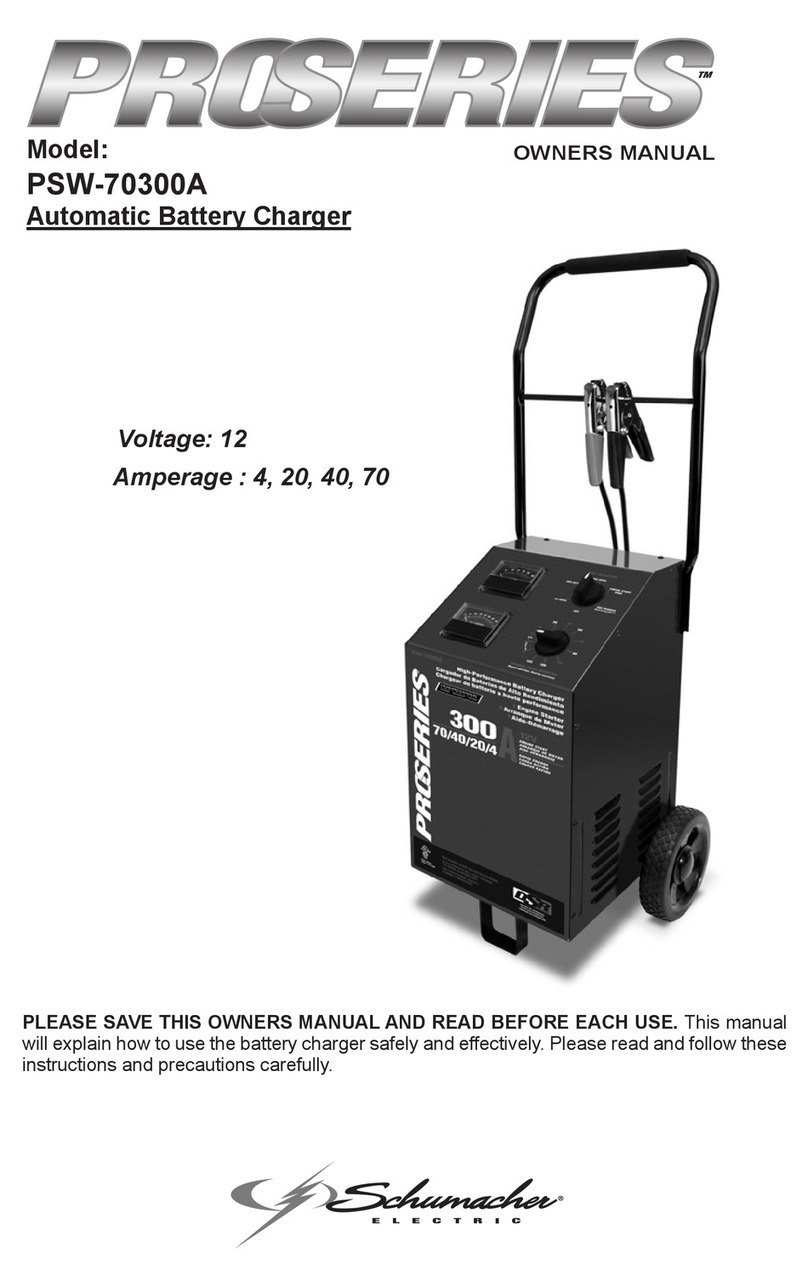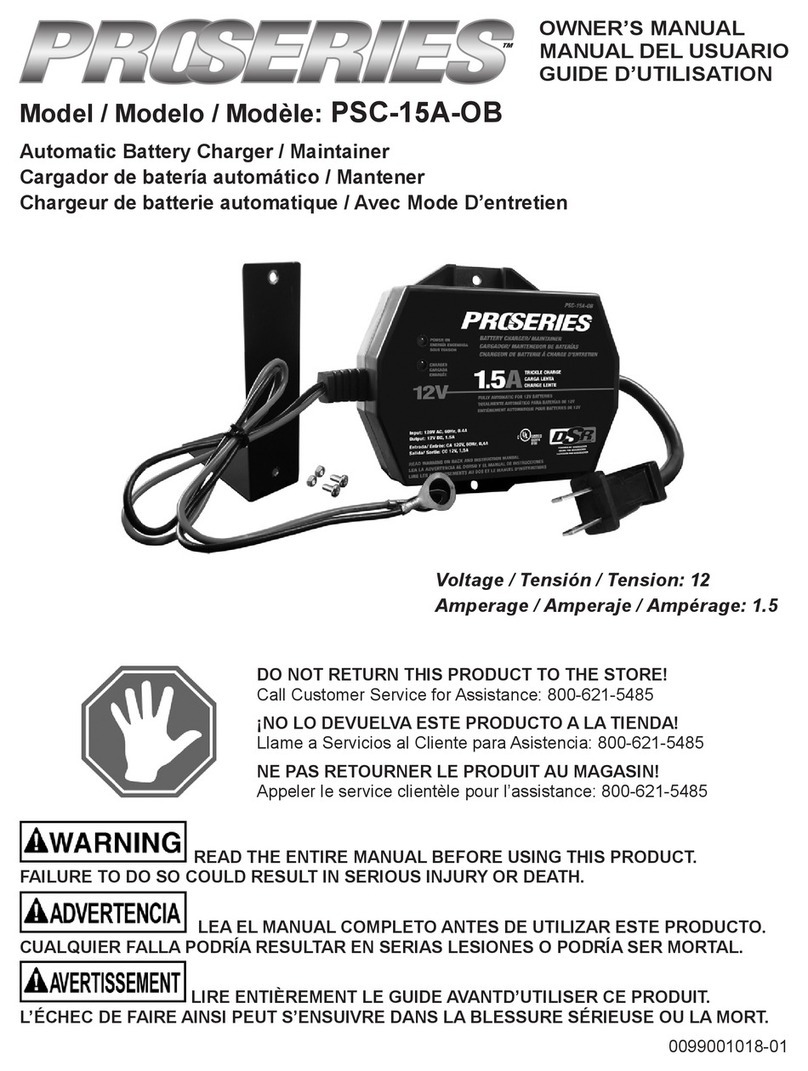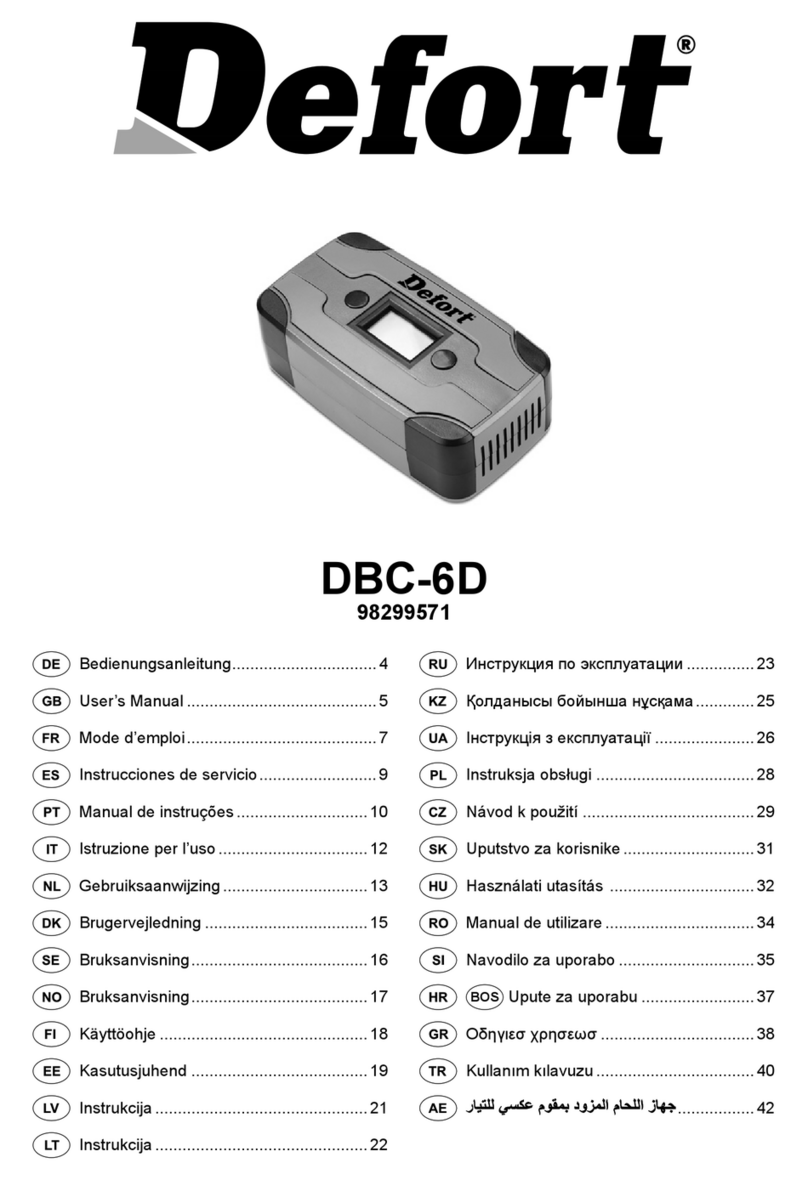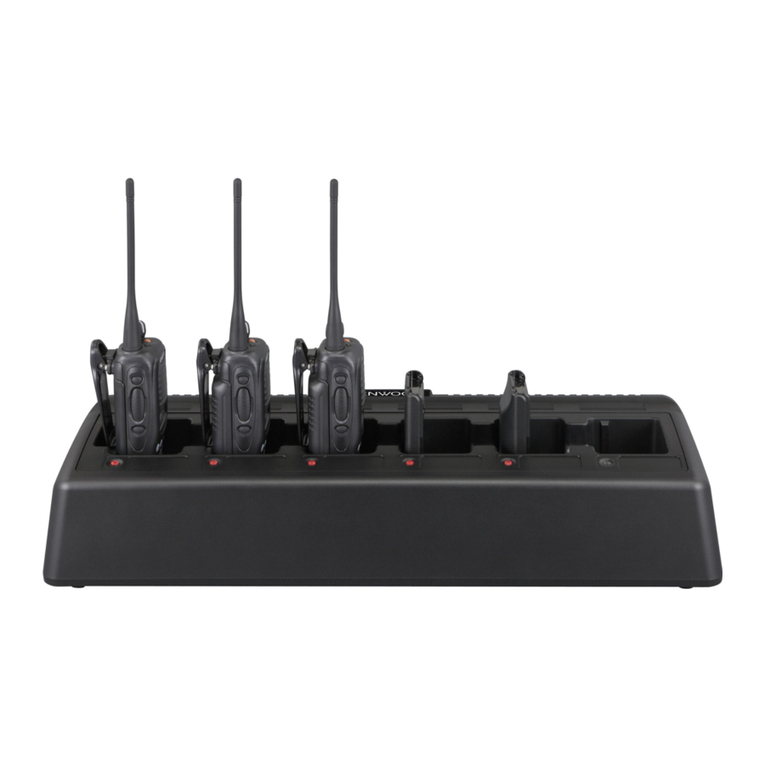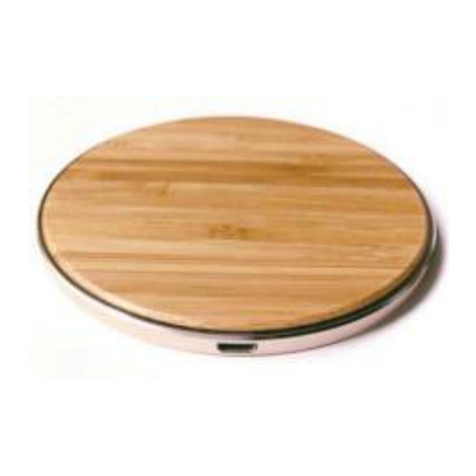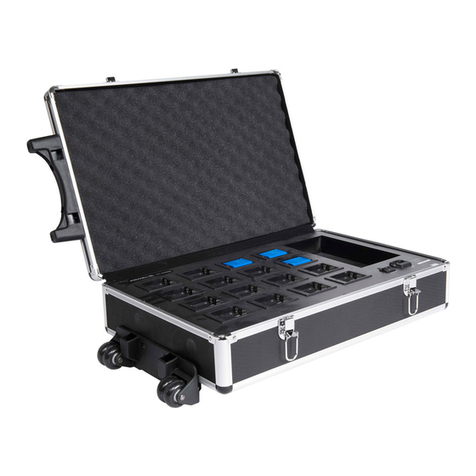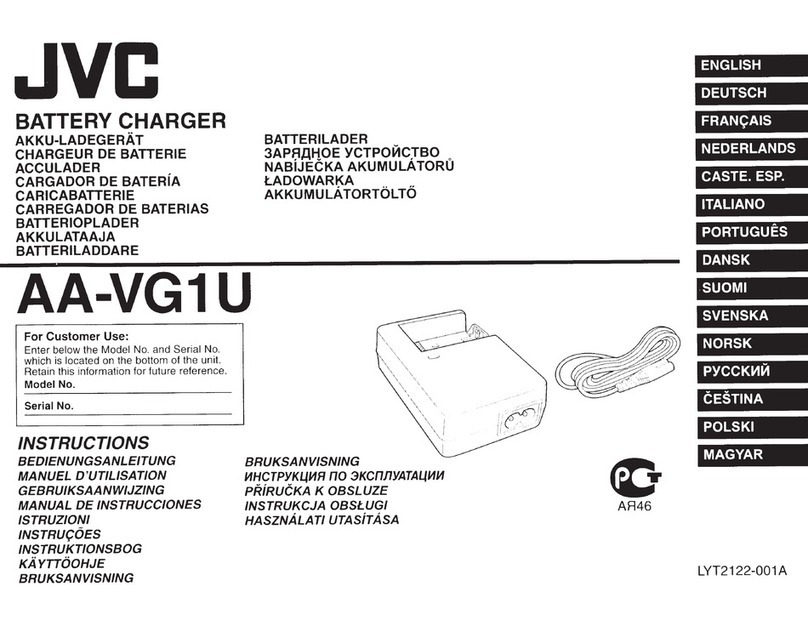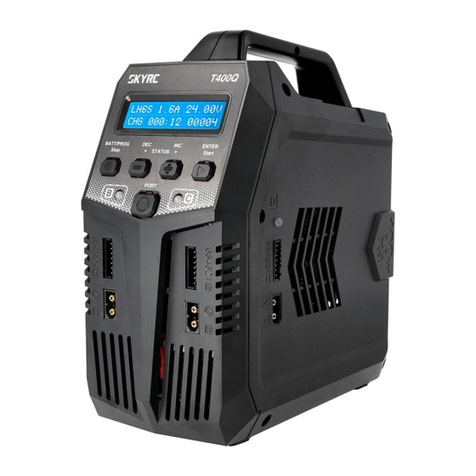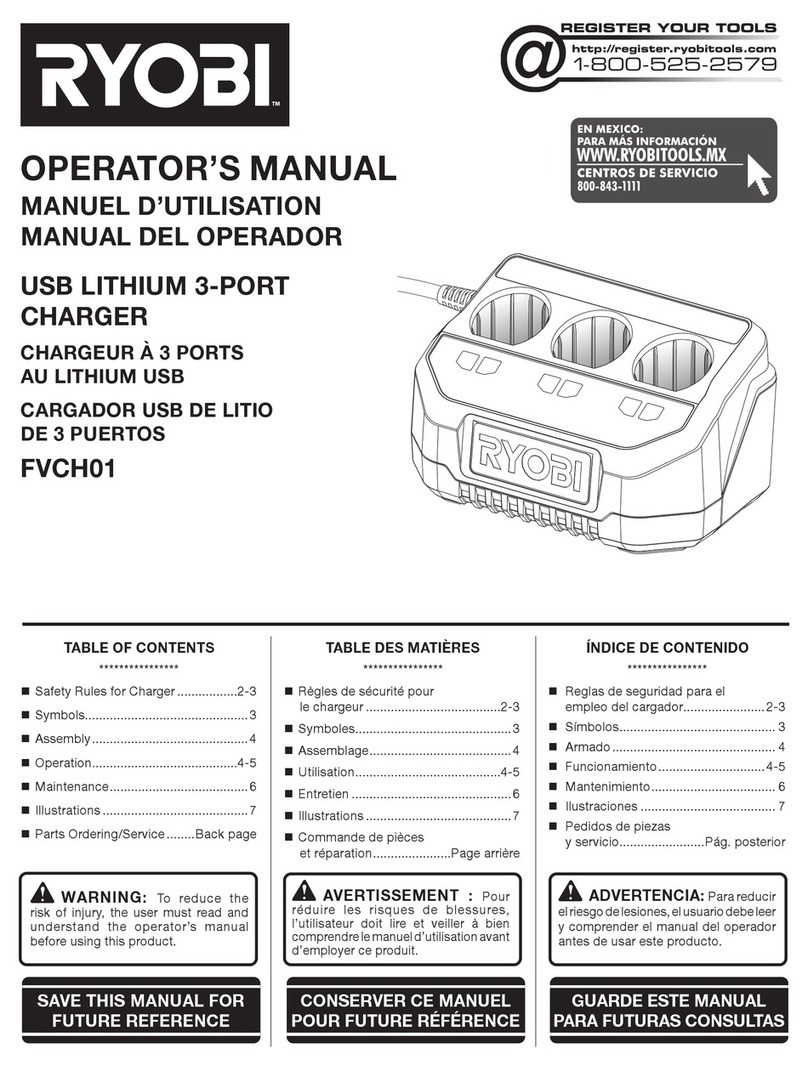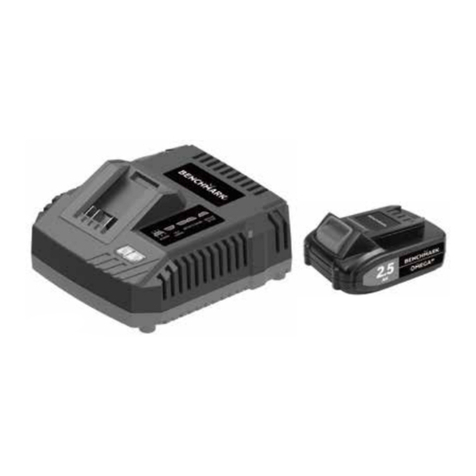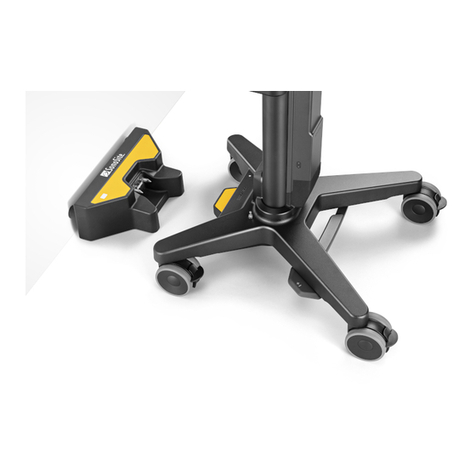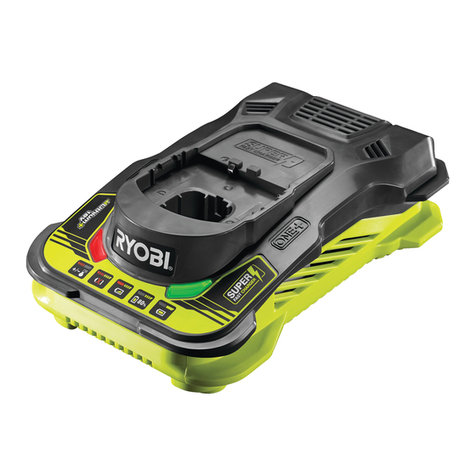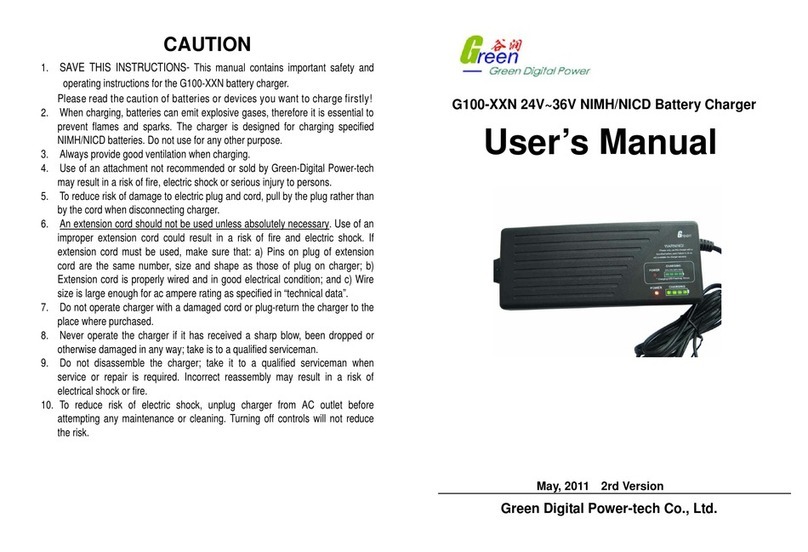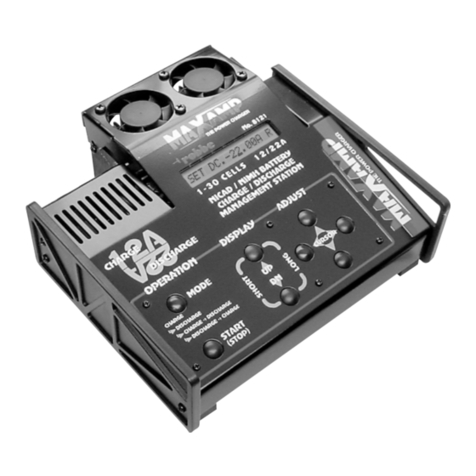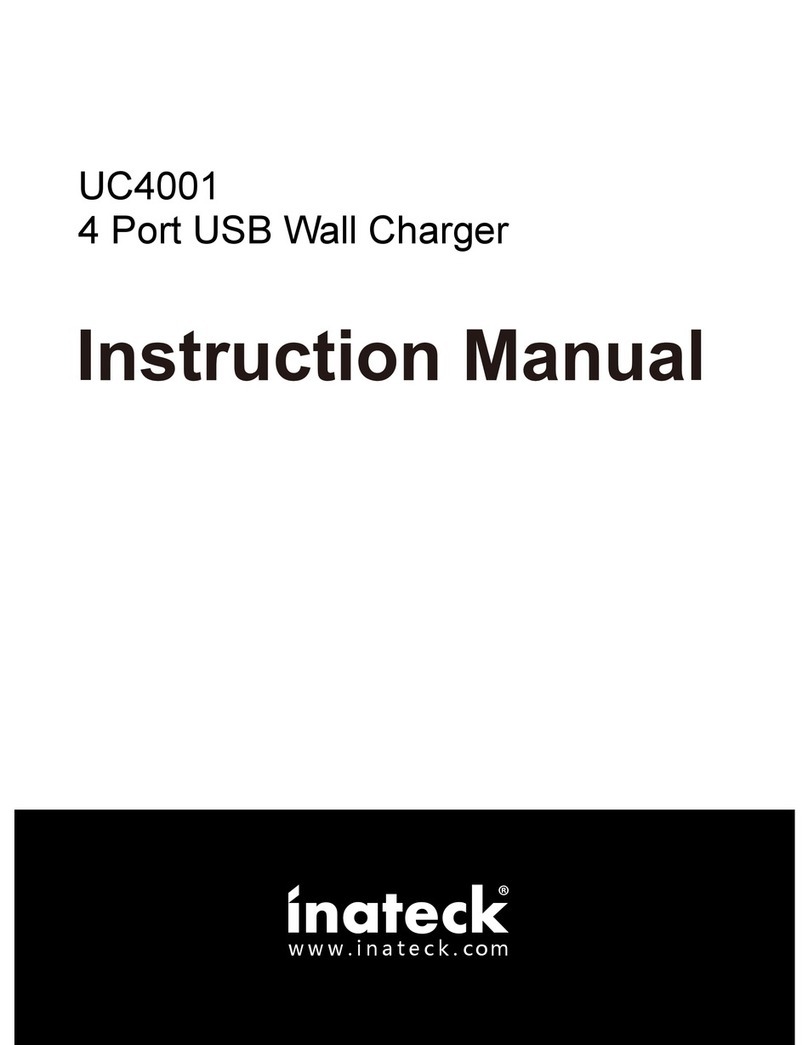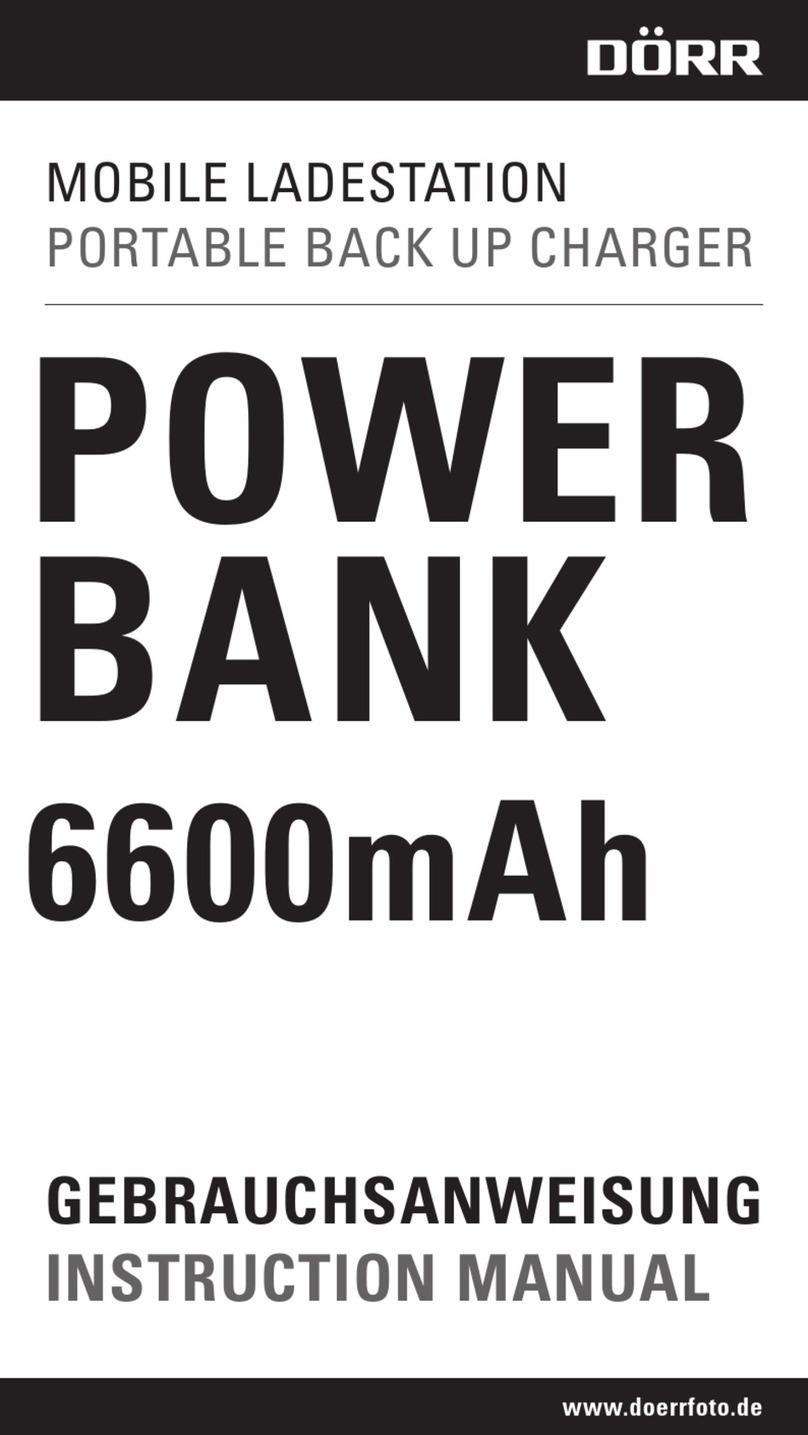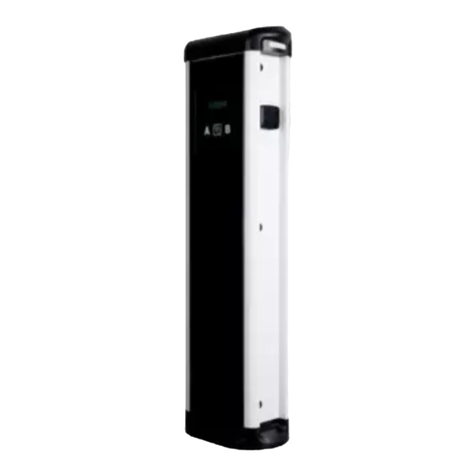Proseries PSW-70300A User manual

00-99-001027/0110
Model / Modelo / Modèle: PSW-70300A
Automatic Battery Charger / Cargador de batería automático /
Chargeur de batterie automatique
Voltage / Tensión / Tension: 12
Amperage / Amperaje / Ampérage: 4, 20, 40, 70
READ THE ENTIRE MANUAL BEFORE USING THIS PRODUCT.• FAILURE TO DO SO CAN RESULT IN SERIOUS INJURY OR DEATH.
LEA EL MANUAL COMPLETO ANTES DE UTILIZAR ESTE PRODUCTO.• CUALQUIER FALLA PODRÍA RESULTAR EN SERIAS LESIONES O PODRÍA
SER MORTAL.
LIRE ENTIÈREMENT LE GUIDE AVANTD’UTILISER CE PRODUIT.• L’ÉCHEC DE FAIRE AINSI PEUT S’ENSUIVRE DANS LA BLESSURE
SÉRIEUSE OU LA MORT.
OWNER’S MANUAL•
MANUAL DEL USUARIO•
GUIDE D’UTILISATION•


TABLE OF CONTENTS
SECTION PAGE
IMPORTANT SAFETY INSTRUCTIONS 2
PERSONAL PRECAUTIONS 2
PREPARING TO CHARGE 3
CHARGER LOCATION 4
DC CONNECTION PRECAUTIONS 4
FOLLOW THESE STEPS WHEN BATTERY IS INSTALLED
IN VEHICLE. 4
FOLLOW THESE STEPS WHEN BATTERY IS OUTSIDE VEHICLE. 5
BATTERY CHARGING – AC CONNECTIONS 5
FEATURES 6
ASSEMBLY INSTRUCTIONS 6
CONTROL PANEL 8
OPERATING INSTRUCTIONS 9
CALCULATING CHARGE TIME 12
MAINTENANCE INSTRUCTIONS 13
STORAGE INSTRUCTIONS 13
TROUBLESHOOTING 14
BEFORE RETURNING FOR REPAIRS 16
LIMITED WARRANTY 16
ÍNDICE
SECCIÓN PÀGINA
INSTRUCCIONES IMPORTANTES DE SEGURIDAD 19
PRECAUCIONES PERSONALES 20
PREPARACIÓN PARA LA CARGA 20
UBICACIÓN DEL CARGADOR 21
PRECAUCIONES DE CONEXIÓN EN CC 21
SIGA ESTOS PASOS CUANDO LA BATERÍA ESTÉ COLOCADA
EN EL VEHÍCULO. 22
SIGA ESTOS PASOS CUANDO LA BATERÍA SE ENCUENTRE
FUERA DEL VEHÍCULO. 22
CARGA DE BATERÍA, CONEXIONES DE CA 23
CARACTERÍSTICAS 24
INSTRUCCIONES DE MONTAJE 24

PANEL DE CONTROL 26
INSTRUCCIONES DE OPERACIÓN 27
CÁLCULO DE TIEMPO DE CARGA 30
INSTRUCCIONES DE MANTENIMIENTO 32
INSTRUCCIONES DE ALMACENAJE 32
LOCALIZACIÓN Y SOLUCIÓN DE PROBLEMAS 33
ANTES DE DEVOLVER A REPARACIONES 36
GARANTÍA LIMITADA 36
TABLE DES MATIÈRES
PARTIE PAGE
CONSIGNES DE SÉCURITÉ IMPORTANTES 39
PRÉCAUTIONS PERSONNELLES 39
PRÉPARATION POUR LE CHARGEMENT 40
EMPLACEMENT DU CHARGEUR 41
PRÉCAUTIONS SUR LA CONNEXION C.C. 41
ÉTAPES À SUIVRE QUAND LA BATTERIE EST INSTALLÉE
DANS UN VÉHICULE. 41
ÉTAPES À SUIVRE QUAND LA BATTERIE EST INSTALLÉE
HORS DU VÉHICULE. 42
CHARGEMENT D’UNE BATTERIE – RACCORDEMENTS C.A. 43
CARACTÉRISTIQUES 43
DIRECTIVES DE MONTAGE 44
PANNEAU DE CONTRÔLE 45
CONSIGNES D’UTILISATION 46
CALCUL DU TEMPS DE CHARGEMENT 49
CONSIGNES D’ENTRETIEN 51
DIRECTIVES D’ENTREPOSAGE 51
TABLEAU DE DÉPANNAGE 52
AVANT DE L’ENVOYER POUR RÉPARATION 55
GARANTIE LIMITÉE 55

•1 •
IMPORTANT: READ AND SAVE THIS SAFETY AND INSTRUCTION MANUAL.
SAVE THESE INSTRUCTIONS – The PSW-70300A offers a wide range of
features to accommodate your needs. This manual will show you how to use
your charger safely and effectively. Please read, understand and follow these
instructions and precautions carefully, as this manual contains important safety
and operating instructions. The safety messages used throughout this manual
contain a signal word, a message and an icon.
The signal word indicates the level of the hazard in a situation.
Indicates an imminently hazardous situation which, if not avoided,
will result in death or serious injury to the operator or bystanders.
Indicates a potentially hazardous situation which, if not avoided,
could result in death or serious injury to the operator or bystanders.
Indicates a potentially hazardous situation which, if not avoided,
could result in moderate or minor injury to the operator or
bystanders.
Indicates a potentially hazardous situation which, if not avoided,
could result in damage to the equipment or vehicle or property
damage.
Safety messages in this manual contain two different type styles.
Unnumbered type states the hazard.•
Numbered type states how to avoid the hazard.•
The icon gives a graphical description of the potential hazard.
Pursuant to California Proposition 65, this product contains chemicals
known to the State of California to cause cancer and birth defects or
other reproductive harm.

•2 •
IMPORTANT SAFETY INSTRUCTIONS1.
Riskofelectricshockorre.
Do not expose the charger to rain or snow.1.1
Use only recommended attachments. Use of an attachment not recommended1.2 orsoldbySchumacher®ElectricCorporationmayresultinariskofre,
electric shock or injury to persons or damage to property.
To reduce the risk of damage to the electric plug or cord, pull by the plug rather1.3 than the cord when disconnecting the charger.
An extension cord should not be used unless absolutely necessary. Use of an1.4 improperextensioncordcouldresultinariskofreandelectricshock.Ifan
extension cord must be used, make sure:
That the pins on the plug of the extension cord are the same number, size•and shape as those of the plug on the charger.
That the extension cord is properly wired and in good electrical condition.•
That the wire size is large enough for the AC ampere rating of the charger•asspeciedinSection8.
To reduce the risk of electric shock, unplug the charger from the outlet before1.5 attempting any maintenance or cleaning. Simply turning off the controls will not
reduce this risk.
Remove personal metal items such as rings, bracelets, necklaces and watches1.6 when working with a lead-acid battery. A lead-acid battery can produce a short-
circuit current high enough to weld a ring or the like to metal, causing a severe
burn.
Donotoperatethechargerwithadamagedcordorplug;takeittoaqualied1.7 service person. (Call customer service at: 1-800-621-5485.)
Do not operate the charger if it has received a sharp blow, been dropped or1.8 otherwisedamagedinanyway;takeittoaqualiedserviceperson.(Call
customer service at: 1-800-621-5485.)
Donotdisassemblethecharger;takeittoaqualiedservicepersonwhen1.9 serviceorrepairisrequired.Incorrectreassemblymayresultinariskofreor
electric shock. (Call customer service at: 1-800-621-5485.)
PERSONAL PRECAUTIONS2.
Risk of explosive gases.
Working in the vicinity of a lead-acid battery is dangerous. Batteries generate2.1 explosive gases during normal battery operation. For this reason, it is of
utmost importance that you follow the instructions each time you use the
charger.
To reduce the risk of a battery explosion, follow these instructions and those2.2 published by the battery manufacturer and the manufacturer of any equipment
you intend to use in the vicinity of the battery. Review the cautionary markings
on these products and on the engine.

•3 •
NEVERsmokeorallowasparkorameinthevicinityofabatteryorengine.2.3
Be extra cautious to reduce the risk of dropping a metal tool onto the battery.2.4 It might spark or short-circuit the battery or other electrical part that may cause
an explosion.
Use this charger for charging LEAD-ACID batteries only. It is not intended to2.5 supply power to a low voltage electrical system other than in a starter-motor
application. Do not use this battery charger for charging dry-cell batteries that
are commonly used with home appliances. These batteries may burst and
cause injury to persons and damage to property.
NEVER charge a frozen battery.2.6
NEVER overcharge a battery.2.7
PREPARING TO CHARGE3.
Risk of contact with battery acid. Battery acid is a
highly corrosive sulfuric acid.
Consider having someone close enough by to come to your aid when you work3.1 near a lead-acid battery.
Have plenty of fresh water and soap nearby in case battery acid contacts your3.2 skin, clothing or eyes.
Wear complete eye and body protection, including safety goggles and3.3 protective clothing. Avoid touching your eyes while working near the battery.
If battery acid contacts your skin or clothing, immediately wash the area with3.4 soapandwater.Ifacidentersyoureye,immediatelyoodtheeyewithcold
running water for at least 10 minutes and get medical attention right away.
If it is necessary to remove the battery from the vehicle to charge it, always3.5 removethegroundedterminalrst.Makesurealloftheaccessoriesinthe
vehicle are off to prevent arcing.
Be sure the area around the battery is well ventilated while the battery is being3.6 charged.
Clean the battery terminals before charging the battery. During cleaning, keep3.7 airborne corrosion from coming into contact with your eyes, nose and mouth.
Use baking soda and water to neutralize the battery acid and help eliminate
airborne corrosion. Do not touch your eyes, nose or mouth.
Adddistilledwatertoeachcelluntilthebatteryacidreachesthelevelspecied3.8 bythebatterymanufacturer.Donotoverll.Forabatterywithoutremovable
cell caps, such as valve regulated lead acid batteries (VRLA), carefully follow
the manufacturer’s recharging instructions.
Read, understand and follow all instructions for the charger, battery, vehicle3.9 and any equipment used near the battery and charger. Study all of the battery
manufacturer’sspecicprecautionswhilechargingandrecommendedratesof
charge.
Determine the voltage of the battery by referring to the vehicle owner’s manual3.10 and make sure that the output voltage selector switch is set to the correct
voltage. If the charger has an adjustable charge rate, charge the battery in the
lowestraterst.
Make sure the charger cable clips make tight connections.3.11

•4 •
CHARGER LOCATION4.
Risk of explosion and contact with
battery acid.
Locate the charger as far away from the battery as the DC cables permit.4.1
Never place the charger directly above the battery being charged; gases from4.2 the battery will corrode and damage the charger.
Do not set the battery on top of the charger.4.3
Never allow battery acid to drip onto the charger when reading the electrolyte4.4 specicgravityorllingthebattery.
Do not operate the charger in a closed-in area or restrict the ventilation in any4.5 way.
DC CONNECTION PRECAUTIONS5.
Connect and disconnect the DC output clips only after setting all of the charger5.1 switches to the “off” position and removing the AC plug from the electrical
outlet. Never allow the clips to touch each other.
Attach the clips to the battery and chassis, as indicated in sections 6 and 7.5.2
FOLLOW THESE STEPS WHEN BATTERY IS INSTALLED IN VEHICLE.6.
A spark near the battery may cause
a battery explosion. To reduce the
risk of a spark near the battery:
Position the AC and DC cables to reduce the risk of damage by the hood, door6.1 and moving or hot engine parts. NOTE: If it is necessary to close the hood
during the charging process, ensure that the hood does not touch the metal
part of the battery clips or cut the insulation of the cables.
Stay clear of fan blades, belts, pulleys and other parts that can cause injury.6.2
Check the polarity of the battery posts. The POSITIVE (POS, P, +) battery post6.3 usually has a larger diameter then the NEGATIVE (NEG, N, -) post.
Determine which post of the battery is grounded (connected) to the chassis.6.4 If the negative post is grounded to the chassis (as in most vehicles), see step
6.5. If the positive post is grounded to the chassis, see step 6.6.
For a negative-grounded vehicle, connect the POSITIVE (RED) clip from the6.5 battery charger to the POSITIVE (POS, P, +) ungrounded post of the battery.
Connect the NEGATIVE (BLACK) clip to the vehicle chassis or engine block
away from the battery. Do not connect the clip to the carburetor, fuel lines or
sheet-metal body parts. Connect to a heavy gauge metal part of the frame or
engine block.
For a positive-grounded vehicle, connect the NEGATIVE (BLACK) clip from the6.6 battery charger to the NEGATIVE (NEG, N, -) ungrounded post of the battery.
Connect the POSITIVE (RED) clip to the vehicle chassis or engine block away
from the battery. Do not connect the clip to the carburetor, fuel lines or sheet-
metal body parts. Connect to a heavy gauge metal part of the frame or engine
block.

•5 •
When disconnecting the charger, turn all switches to off, disconnect the AC6.7 cord, remove the clip from the vehicle chassis and then remove the clip from
the battery terminal.
See CALCULATING CHARGE TIME for length of charge information.6.8
FOLLOW THESE STEPS WHEN BATTERY IS OUTSIDE VEHICLE.7.
A spark near the battery may
cause a battery explosion. To
reduce the risk of a spark near the
battery:
Check the polarity of the battery posts. The POSITIVE (POS, P, +) battery post7.1 usually has a larger diameter than the NEGATIVE (NEG, N, -) post.
Attach at least a 24-inch (61 cm) long 6-gauge (AWG) insulated battery cable7.2 to the NEGATIVE (NEG, N, -) battery post.
Connect the POSITIVE (RED) charger clip to the POSITIVE (POS, P, +) post7.3 of the battery.
Position yourself and the free end of the cable you previously attached to the7.4 NEGATIVE (NEG, N, -) battery post as far away from the battery as possible –
then connect the NEGATIVE (BLACK) charger clip to the free end of the cable.
Donotfacethebatterywhenmakingthenalconnection.7.5
When disconnecting the charger, always do so in the reverse order of the7.6 connectingprocedureandbreaktherstconnectionwhileasfarawayfromthe
battery as practical.
A marine (boat) battery must be removed and charged on shore. To charge it7.7 onboard requires equipment specially designed for marine use.
BATTERY CHARGING – AC CONNECTIONS8.
Riskofelectricshockorre.
This battery charger is for use on a nominal 120-volt8.1 circuit and has a grounded plug that looks like the plug
illustrated. The charger must be grounded to reduce
the risk of electric shock. The plug must be plugged
into an outlet that is properly installed and grounded in
accordance with all local codes and ordinances. The
plugpinsmusttthereceptacle(outlet).Donotusewith
an ungrounded system.
NeveraltertheACcordorplugprovided–ifitdoesnotttheoutlet,have8.2 apropergroundedoutletinstalledbyaqualiedelectrician.Animproper
connection can result in a risk of an electric shock or electrocution.
NOTE: Pursuant to Canadian Regulations, use of an adapter plug is not
allowed in Canada. Use of an adapter plug in the United States is not
recommended.
Recommended minimum AWG size for extension cord:8.3
100 feet long or less - use an 10 gauge extension cord.•
Over 100 feet long - use a 8 gauge extension cord.•

•6 •
FEATURES9.
Ammeter1.
Voltmeter2.
Foam Grip3.
Fiberglass Clip Rod4.
Battery Clips5.
Charge Rate Selector6. Switch
Timer7.
Wheel8.
1
2
3
4
5
6
7
8
ASSEMBLY INSTRUCTIONS10.
It is important to fully assemble your charger before use. Follow these
instructions for assembly.
Item PARTS TOOLS NEEDED
1
2
3
4
5
6
7
8
9
10
11
12
(2) axle brackets
(1) axle with pin holes
(2) wheels
(2) 10-32, thread cutting screws
(2) ¼-20, thread cutting screws
(1) foot
(2) axle caps
(2) hairpin cotter
(4) 8-18 sheet metal screws
(1) handle
(1)berglassclamprod
(1) foam handle grip
3/8” wrench (for mounting foot)
5/16” wrench (for mounting wheels)
1/4” wrench (for mounting handle)
hammer
screwdriver(atblade)
screwdriver (Phillips)

•7 •
Carefully lay the charger on its front to prepare for assembly.1.
Assemble the foot (Item 6) using two ¼-20 screws (Item 5) and tighten2. securely.
Attach the two axle brackets (Item 1) using one 10-32 screw (Item 4) in3. each. The brackets should have one end hooked into the slot in the charger
base. Be careful not to drop the brackets inside of the charger case. Do not
completely tighten the screws (Item 4) at this time.
Slide the axle (Item 2) into the brackets (Item 1) until centered on the4. charger.
Slide one wheel (Item 3) onto the axle with the recessed hub facing out as5. shown.
Insert the pin (Item 8) through the axle hole.6.
Repeat this process for the other wheel and when both wheels have been7. pinnedtotheaxle,nishtighteningthetwoaxlebracketscrews(Item4).
Snap the axle caps (Item 7) onto each wheel to cover the pin and axle.8.
Lift the charger upright so that it rests on the wheels and foot.9.
Remove the two top side screws (Item 9) from each side of the charger.10.
Verify that the foam handle grip (Item 12) is on the handle assembly (Item11.
10). Install if needed.
Inserttheberglassclamprod(Item11)intothepiercedholesontheinside12.
of the handle (Item 10).
Align the handle assembly (Item 10) with charger and reinstall the side13.
screws (Item 9). Do not over tighten.
The charger assembly is now complete. The battery clips can be clamped14.
totheberglassrod(Item11)forconvenientstorage.
Do not attach the clips to the foam area of the handle; this will damage the15.
foam grip.
10
12
11
9

•8 •
CONTROL PANEL11.
Timer
Timer Setting• :Thetimerallowsyoutosetaspeciedtimeforcharging.
After the timer expires, the charger stops charging your battery. The main
function of the timer is to prevent over charging while allowing a battery
time to obtain a satisfactory charge. To properly set the timer, you must
know the size of the battery in ampere hours or reserve capacity in minutes
and the state of charge. It is important that you determine the appropriate
stateofchargeofyourbatteryasspeciedinSection13andsetthetimer
accordingly.
Hold• : This position defeats the timer function, allowing for continuous
operation.
Automatic Modes:◦Put the timer in the HOLD position when using
the battery charger in one of the Automatic Modes (4, 20 or 70 amp),
otherwise the timer will stop the charging process when the time
expires regardless of whether it is complete or not. The CHARGED
(green) LED will light when charging is complete and the charger goes
into Maintain Mode. The charger will not shut off.
Manual Modes:◦Put the timer in the HOLD position when using the
battery charger in the Manual Mode (40 amp) and when you want to
charge more than 2¼ hours. Be sure to monitor the charging progress
and stop it when the battery is charged. Not doing so may cause
damage to your battery or may cause other personal property damage
or personal injury.
Ammeter
The Ammeter indicates the amount of current, measured in amps, that is being
drawn by the battery. As a battery takes on a charge, it draws less current from
the charger. Correspondingly, the meter will show less current being drawn by
the battery. When the current stops decreasing, the battery is charged. The 4
amp charge rate may indicate some activity on the meter, although the meter
does not have the resolution to display this low rate.
Voltmeter
The voltmeter indicates the voltage at the battery terminals. The charger need
not be plugged into an AC outlet. The timer should be in the OFF position.
Then connect the charger following the instructions in Sections 6 and 7.
Observe the meter indication. Keep in mind that this reading is only a battery
voltage reading, a false surface charge may mislead you. We suggest that you
turn on the headlights for a couple of minutes before you read the meter. Read
it a couple of minutes after you have shut the headlights off. If the reading is
less than 10.5-volts, the battery may be bad or the connection at the charger
may be poor. If the reading is 10.5-volts to 12.8-volts, the battery is low –
recharge it. If the reading is above 12.8-volts, the battery is charged.
Charge Rate Selector Switch
Use the Charge Rate selector switch to select the charge rate or engine
starting setting you require.
4A Slow Charge Rate• – Intended for charging small batteries such as
those commonly used in garden tractors, snow mobiles and motorcycles.
20A and 40A Fast and 70A Rapid Charge Rate• – Use for charging
automotive, marine and deep-cycle batteries. Not intended for industrial
applications.
300A Engine Start• – Provides 300 amps for cranking an engine with a
weak or run down battery. Always use in combination with a battery.

•9 •
OPERATING INSTRUCTIONS12.
Automatic Temperature Compensation
The charger adjusts the maximum charge voltage and maximum maintain
voltage based on the ambient air temperature. This permits optimum charging
and safety.
Thermal Runaway
The charger automatically reduces the current if it detects the battery may be
getting too hot. This is a safety precaution.
Charging
Ensure that all of the charger components are in place and in good working1. condition, including the plastic boots on the battery clips. Make sure the
electrolyte (battery liquid) in each cell is at the correct level.
Set the charge rate switch and the timer to the OFF position.2.
Connect the battery following the precautions listed in Sections 6 and 7.3.
Connect the AC power following the precautions listed in Section 8.4.
Select the desired charge rate. NOTE: The 40 amp Manual rate is a5. manual mode and will overcharge a battery if permitted to operate for
extended periods of time. Monitor the charging process often.
Turn the timer to HOLD or the selected charge time if using the 40 amp6. Manual Mode.
To disconnect the charger, reverse the procedure.7.
NOTE: This charger is equipped with a safe start feature. In the Automatic 4,
20 and 70 amp charge rates it will not supply current to the battery clips until
a battery is properly connected. Unlike traditional chargers, the clips will not
spark if touched together. In the Manual 40 amp charge rate, the clips will
spark if accidently touched together.
Automatic Charging Mode
When an Automatic Charge is performed, the charger switches to the Maintain
Mode (see below) automatically after the battery is charged. For a battery with
a starting voltage under 1 volt, use the Manual Mode (see Manual Charging
section)rsttopre-chargethebatteryforveminutestogetadditionalvoltage
into the battery for the charger to analyze.
Manual Charging Mode
When you select the 40 Amp Manual Mode charge rate, you will be charging
in manual mode. You must set the timer to the proper time (see Timer section).
Be sure to monitor the charging procedure and stop it when the battery is
charged. Not doing so may cause damage to your battery or result in other
property damage or personal injury.
Aborted Charge
If charging can not be completed normally, charging will abort. When charging
aborts, the charger’s output is shut off. To reset after an aborted charge, either
disconnect the battery or unplug the charger.
Desulfation Mode
If the battery is left discharged for an extended period of time, it could become
sulfated and not accept a normal charge. If the charger detects a sulfated
battery, the charger will switch to a special mode of operation designed for
such batteries. If successful, normal charging will resume after the battery is
desulfated. Desulfation could take 8 to 10 hours. If desulfation fails, charging
will abort (see Aborted Charge section).

•10 •
Completion of Charge
Charge completion is indicated by the CHARGED (green) LED. When lit, the
charger has switched to the Maintain Mode of operation.
Maintain Mode (Float-Mode Monitoring)
When the CHARGED (green) LED is lit, the charger has started Maintain
Mode. In this mode, the charger keeps the battery fully charged by delivering
a small current when necessary. If the battery voltage drops below a preset
level, the charger will go back into Charge Mode until the battery voltage
returns to the full charge level, at which point the charger will return to Maintain
Mode.
NOTE: The charger automatically switches between Charge Mode and
Maintain Mode as necessary. The CHARGED (green) LED will cycle on when
the battery is at full charge and off when the voltage drops below a preset
level and the charger goes into Charge Mode. This cycle will continue, and the
CHARGED (green) LED will stay on for longer periods of time as the battery
becomes more fully charged.
Using the Engine Start feature
Your battery charger can be used to jumpstart your car if the battery is low.
Follow these instructions on how to use the ENGINE START feature.
Follow all safety instructions and precautions for charging
your battery. Wear complete eye protection and clothing protection. Charge
your battery in a well-ventilated area.
Using the ENGINE START feature WITHOUT a battery
installed in the vehicle could cause damage to the vehicle’s electrical system.
NOTE: If you have charged the battery and it still will not start your car, do not
use the engine start feature, or it could damage the vehicle’s electrical system.
Set the charge rate switch and the timer to the OFF position.1.
With the charger unplugged from the AC outlet, connect the charger to2. the battery following the instructions given in Section 6 (FOLLOW THESE
STEPS WHEN THE BATTERY IS INSTALLED IN A VEHICLE).
Plug the charger AC power cord into the AC outlet, and then move the timer3. switch from OFF to the HOLD position.
With the charger plugged in and connected to the battery of the vehicle, set4. the charge rate selector switch to the engine start position.
Crank the engine until it starts or 3 seconds pass. If the engine does not5. start, wait 3 minutes before cranking again. This allows the charger and
battery to cool down.
NOTE: During extremely cold weather, or if the battery is under 2 volts, charge
the battery for 5 minutes before cranking the engine.
If the engine fails to start, charge the battery for 5 more minutes before6. attempting to crank the engine again.
After the engine starts, move the charge rate selector switch to the OFF7. position and unplug the AC power cord before disconnecting the battery
clips from the vehicle.
Clean and store the charger in a dry location.8.
NOTE: If the engine does turn over but never starts, there is not a problem
with the starting system; there is a problem somewhere else with the vehicle.
STOP cranking the engine until the other problem has been diagnosed and
corrected.

•11 •
Using the Battery Voltage Tester
Overview
This battery charger has a built-in voltmeter to test your battery’s state of
charge. The charger does not have a built in load tester. As such, a recently
charged battery could have a temporarily high voltage due to what is known as
“surface charge”. The voltage of such a battery will gradually drop during the
period immediately after the charging system is disengaged. Consequently, the
tester could display inconsistent values for such a battery. For a more accurate
reading, the surface charge should be removed by temporarily creating a load
on the battery, such as by turning on lights or other accessories for a couple
of minutes before you read the display. Read it a couple of minutes after you
have shut the headlights off.
Testing Sequence: There are four basic steps required to test the battery
state of charge:
With the charger unplugged from the AC outlet, connect the charger to the1. battery following the instructions given in Sections 6 and 7.
Set the charge rate switch and the timer to the OFF position.2.
Plug the charger AC power cord into the AC outlet, following the3. instructions given in Section 8.
Read the voltage on the voltmeter.4.
Using the Alternator Performance Tester
Overview
This battery charger has a built-in alternator tester that displays an estimate of
the alternator’s relative output compared to normal alternators. The alternator
% values displayed should be taken as a general reference, not a precise
diagnosis. The alternator tester functions the same as the built-in battery
voltage tester (see previous section for details) with a few differences.
Testing Sequence: There are four basic steps required to operate this unit as
an alternator tester:
With the charger unplugged from the AC outlet, connect the charger to the1. battery following the instructions given in Sections 6 and 7.
Set the charge rate switch and the timer to the OFF position.2.
Plug the charger AC power cord into the AC outlet, following the3. instructions given in Section 8.
Start the vehicle and turn on the vehicle’s headlights. Read the voltage on4. the voltmeter.
General Charging Notes
Fan:Thechargerisdesignedtocontrolitscoolingfanforefcientoperation.
Consequentially, it is normal for the fan to start and stop when maintaining a
fully charged battery. Keep the area near the charger clear of obstructions to
allowthefantooperateefciently.
Voltage: The voltage displayed during charging is the charging voltage and is
usually higher than the battery’s resting voltage.

•12 •
CALCULATING CHARGE TIME13.
The Hydrometer or Electronic Method
Tondthetimeneededtofullychargeyourbattery,determinethebattery’s
charge level with a hydrometer or electronic Percent-of-Charge Tester. The
following table will help you convert hydrometer readings to percent of charge
values.
SPECIFIC GRAVITY PERCENT OF CHARGE PERCENT OF CHARGE
NEEDED
1.265 100% 0%
1.225 75% 25%
1.155 25% 75%
1.120 0% 100%
When you know the percent of charge and the Amp Hour (AH) rating of your
battery, you can calculate the approximate time needed to bring your battery to
a full charge.
To convert Reserve Capacity to Amp Hours, divide Reserve Capacity by 2, and
add 16:
Example:
Amp Hour Rating = Reserve Capacity + 16
2
NOTE:TheReserveCapacitycanbeobtainedfromthebatteryspecication
sheet or the owner’s manual.
To calculate the time needed for a charge:
Find the percent of charge needed. (A battery at 50 percent charge that will1. be charged to 100 percent needs another 50 percent (.50)).
Multiply the Amp Hour Rating by the charge needed (.50) and divide by the2. charge rate.
Multiply the results by 1.25 and you will have the total time needed, in3. hours, to bring the battery to full charge.
Add an additional hour for a deep-cycle battery.4.
Example:
Amp Hour Rating x % of charge needed x 1.25 = hours of charge
Charger Setting
100 (AH Rating) x .50 (charge needed) x 1.25 = 3.125 hours
20 (Charger Setting)
100 x .50 x 1.25 = 3.125
20
You would need to charge your 100-Ampere Hour Battery for a little more than
3 hours at the 20-Amp charge rate using the above example.

•13 •
The Chart Method
Use the following table to more accurately determine the time it will take to
bringabatterytofullcharge.First,identifywhereyourbatterytsintothe
chart.
NR means that the charger setting is NOT RECOMMENDED.
Find your battery’s rating on the chart below, and note the charge time given
for each charger setting. The times given are for batteries with a 50% charge
prior to recharging. Add more time for severely discharged batteries.
BATTERY SIZE/RATING CHARGE RATE/CHARGING TIME
4 AMP 20 AMP 40 AMP 70 Amp
SMALL
BATTERIES
Motorcycle,
garden,
tractor, etc.
6 - 12 AH 1 - 2 hrs NR NR NR
12 - 32 AH 2 - 5 hrs NR NR NR
CARS/
TRUCKS
200 - 315 CCA 40 - 60 RC 5½ - 7¼
hrs 1 - 1½
hrs ½ - ¾ hr 20 - 30
min
315 - 550 CCA 60 - 85 RC 7¼ - 9¼
hrs 1½ - 2
hrs ¾ - 1 hr 30 - 40
min
550 - 1000 CCA 80 - 190 RC 9¼ -
17½ hrs 2 - 3½
hrs 1 - 1¾
hrs 40 min -
1 hr
MARINE/DEEP CYCLE
80 RC 8¾ hrs 1¾ hrs NR NR
140 RC 13½ hrs 2¾ hrs NR NR
160 RC 15 hrs 3 hrs NR NR
180 RC 16½ hrs 3½ hrs NR NR
MAINTENANCE INSTRUCTIONS14.
After use and before performing maintenance, unplug and disconnect the14.1 battery charger (see Sections 6, 7 and 8).
Use a dry cloth to wipe all battery corrosion and other dirt or oil from the14.2 terminals, cords, and the charger case.
Ensure that all of the charger components are in place and in good working14.3 condition, including the plastic boots on the battery clips.
Servicing does not require opening the unit, as there are no user-serviceable14.4 parts.
STORAGE INSTRUCTIONS15.
Store the charger unplugged, in an upright position. The cord will still conduct15.1 electricity until it is unplugged from the outlet.
Store inside, in a cool, dry place.15.2
Storetheclipsontheberglassclamprod.Donotstorethemonthehandle,15.3 clipped together, on or around metal, or clipped to the cables.

•14 •
TROUBLESHOOTING16.
PROBLEM POSSIBLE CAUSE REASON/SOLUTION
No reading on the
ammeter. Charger is not plugged in.
No power at the receptacle.
Clips are not making a good
connection to the battery.
Connections are reversed.
Battery is defective (will not
accept a charge).
4 amp charge rate is being
used.
Plug the charger into an AC
outlet.
Check for open fuse or
circuit breaker supplying AC
outlet.
Check for poor connection
to battery and frame. Make
sure connection points are
clean. Rock clips back and
forth for a better connection.
Unplug the charger and
reverse the clips.
Have battery checked.
Ammeter may show no
activity at the 4A charge
rate.
Ammeter reading stays
high. Battery is severely
discharged.
Wrong battery voltage.
Continue charging battery
for two more hours. If
problem continues have the
battery checked.
Verify the voltage settings on
the charger are correct.
Ammeter reads less than
selected charge rate when
charging a discharged
battery
Extension cord is too long
or wire gauge is too small.
Weak cell or sulfated plate
in battery.
Battery is only partially
discharged.
Use a shorter or heavier
gauge extension cord.
A sulfated battery will
eventually take a normal
charge if left connected. If
the battery will not take a
charge, have it checked.
Continue to charge the
battery.
Battery clips do not spark
when touched together. The charger is equipped
with a safe start feature. In
the automatic modes, it will
not supply current to the
battery clips until a battery
is properly connected.
Unlike traditional chargers,
the clips will no spark if
touched together.
No problem, this is a normal
condition.

•15 •
PROBLEM POSSIBLE CAUSE REASON/SOLUTION
The charger is making an
audible clicking sound. Circuit breaker is cycling.
Battery is defective.
Shorted battery cables or
clips.
Severely discharged battery,
but otherwise it is a good
battery.
Reverse connections at
battery.
The settings may be wrong.
Check the charger settings.
Have the battery checked.
Circuit breaker cycles when
current draw is too high.
Check for shorted cables
or clips and replace if
necessary.
The battery may not want
to accept a charge due to
a run-down state. Allow
charging to continue until
battery has a chance to
recoversufcientlytotake
a charge. If more than 20
minutes, stop charging and
have the battery checked.
Shut the charger off and
correct the lead connections.
Charger makes a loud buzz
or hum. Transformer laminations
vibrate (buzz).
Shorted Diode Assembly or
OutputRectierAssembly
(hum).
No problem, this is a normal
condition.
Have charger checked by a
qualiedtechnician.
Short or no start cycle
when cranking engine. Drawing more than 300
amps.
Failure to wait 3 minutes
(180 seconds) between
cranks.
Clips are not making a good
connection.
AC cord and/or extension
cord is loose.
No power at receptacle.
The charger may be
overheated.
Battery may be severely
discharged.
Crank time varies with the
amount of current drawn. If
cranking draws more than
300 amps, crank time may
be less than 3 seconds.
Wait 3 minutes of rest time
before the next crank.
Check for poor connection at
battery and frame.
Check power cord and
extension cord for loose
ttingplug.
Check for open fuse or
circuit breaker supplying AC
outlet.
The thermal protector may
have tripped and needs a
little longer to reset. Make
sure the charger vents are
not blocked. Wait and try
again.
On a severely discharged
battery, charge for 10 to
15 minutes in the 40 amp
manual rate to help assist in
cranking.

•16 •
PROBLEM POSSIBLE CAUSE REASON/SOLUTION
Charger will not turn on
when properly connected. AC outlet is dead.
Poor electrical connection.
Check for open fuse or
circuit breaker supplying AC
outlet.
Check power cord and
extension cord for loose
ttingplug.
The battery is connected
and the charger is on, but
is not charging.
Clips are not making a good
connection. Check for poor connection
at battery and frame. Make
sure connecting points are
clean. Rock clips back and
forth for a better connection.
The measured current is
much lower than what was
selected.
The charger reached the
maximum voltage and is
reducing the current.
No problem, this is a normal
condition.
BEFORE RETURNING FOR REPAIRS17.
When a charging problem arises, make certain that the battery is capable17.1 of accepting a normal charge. Use a good battery to double check all
connections, the AC outlet for a full 120-volts, the charger clips for correct
polarity and the quality of the connections from the cables to the clips and from
the clips to the battery system. The clips must be clean.
When a battery is very cold, partially charged or sulfated, it will not draw17.2 the full rated amperes from the charger. It is both dangerous and damaging
to a battery to force higher amperage into it than it can effectively use in
recharging.
When an UNKNOWN OPERATING PROBLEM arises, please read the17.3 complete manual and call the customer service number for information that will
usually eliminate the need for return.
If the above solutions do not eliminate the problem or for information about troubleshooting
or replacement parts, call toll-free from anywhere in the U.S.A.
1-800-621-5485
7:00 am to 5:00 pm Central Time Monday thru Friday
LIMITED WARRANTY18.
SCHUMACHER ELECTRIC CORPORATION, 801 BUSINESS CENTER
DRIVE, MOUNT PROSPECT, IL 60056-2179, MAKES THIS LIMITED
WARRANTY TO THE ORIGINAL RETAIL PURCHASER OF THIS PRODUCT.
THIS LIMITED WARRANTY IS NOT TRANSFERABLE OR ASSIGNABLE.
Schumacher Electric Corporation (the “Manufacturer”) warrants this battery
charger for 3 years from the date of purchase at retail against defective
material or workmanship that may occur under normal use and care. If your
unit is not free from defective material or workmanship, Manufacturer’s
obligation under this warranty is solely to repair or replace your product with a
new or reconditioned unit at the option of the Manufacturer. It is the obligation
of the purchaser to forward the unit, along with mailing charges prepaid
to the Manufacturer or its authorized representatives in order for repair or
replacement to occur.
Other manuals for PSW-70300A
1
Table of contents
Languages:
Other Proseries Batteries Charger manuals
